Mauricio Pochettino’s more-than-one-year-long hiatus from football management came to an end on 2nd January when the former Tottenham Hotspur manager returned to Paris Saint-Germain, where he spent over two years as a player from January 2001 until July 2003, to succeed now-Chelsea boss Thomas Tuchel as manager of the defending Ligue 1 champions.
In his first month as PSG boss, Pochettino has overseen six games in total, winning four, drawing one, and losing one.
As a disclaimer, it’s early days in Pochettino’s tenure at Le Parc des Princes, and it’s difficult to definitively say whether or not all of the tactics and ideas that he’s implemented thus far will 1.
Remain in his plans for the long-term and 2.
Succeed/fail in the long-term.
This tactical analysis doesn’t serve to determine either of those two things nor does it really serve to compare and contrast him with Tuchel.
This tactical analysis piece examines the first steps of Pochettino’s PSG journey by looking at some of the key elements to his tactics and philosophy that he’s displayed in the early days of his time in Paris, as well as looking at trends from his previous jobs, to try and determine what Pochettino has immediately set out to do in his new job and how fans of the Ligue 1 side could expect to see their club evolve moving forward under the Argentinian coach.
Mauricio Pochettino Formation
PSG utilised a two-man midfield, deploying a 4-4-2 or a variant of that shape, quite a lot under Tuchel.
By doing so, the German coach could field a four-man attack featuring Neymar, Kylian Mbappé, Mauro Icardi and Ángel Di María.
This season, however, Tuchel lined his team up in a 4-3-3 formation more often than any other shape – 37% of the time.
This could largely have been enforced on him, rather than a preference of his, with Neymar, Mbappé and particularly Icardi spending some time sidelined due to injury.
On his arrival at Le Parc des Princes, however, Pochettino has almost exclusively used a two-man midfield.
Throughout his managerial career, it’s become apparent that Pochettino’s preferred shape is the 4-2-3-1.
Certain roles within that shape have also become synonymous with the Argentinian coach’s tactics, for example, as was evident through his use of Dele Alli in north London, you might say that he likes the ‘number 10’ in his system to essentially be a second striker-type rather than an attacking midfielder-type.
Pochettino has utilised several different formations at PSG so far, including the 4-4-2 that Tuchel tended to use, but he has mainly set his side up in his usual 4-2-3-1 shape.
Given that you could call this his ‘trademark’ formation and he has started utilising it almost immediately in Paris, it seems reasonable to suggest that his team will ideally be moulded in this shape moving forward.
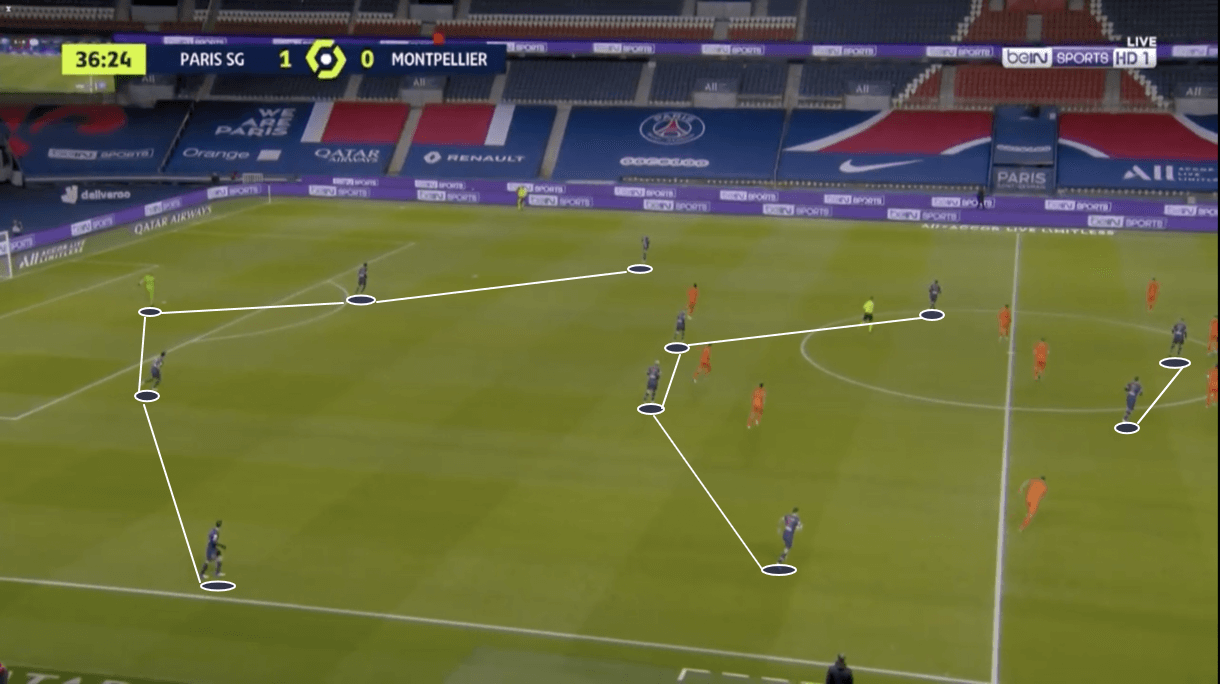
The image above shows us an example of Pochettino’s shape in the build-up during his side’s emphatic 4-0 win over Montpellier on 22nd January.
For the majority of this game, PSG lined up in a 4-2-3-1 shape, even though it looks more like a 4-4-2 here, because the ‘10’ is positioned very high up the pitch.
PSG’s famous front four were all in action in this game as well, so this gives us a clear idea of how Pochettino may view his side progressing, in an ideal world, moving forward.
The only ‘fixed’ member of the attack in most of PSG’s games under Pochettino so far has been Icardi – he always operates as the ‘number 9.’ The rest of the attackers interchange positions, though Di María will typically be found on the right and the duo of Neymar and Mbappé will swap positions with each other far more often.
Neymar or Mbappé have generally occupied the ‘number 10’ role within Pochettino’s system so far, while the other will sit on the left-wing at that time.
Neymar tends to come deep into midfield more when he’s playing the role, while Mbappé will do that less.
Meanwhile, as we can see, Marco Verratti and Leandro Paredes are playing as the double-pivot.
Both men are very press-resistant and good ball progressors via their passing and this is key for Pochettino’s tactics, as we move on to another key element of the 2018/19 UEFA Champions League runner-up’s game plan and how it has already become apparent in the early days of his PSG reign.
Mauricio Pochettino Progressive passes
Similar to ex-PSG boss Tuchel, Pochettino’s teams have always played a relatively high number of progressive passes (a pass that takes the team on the ball ‘significantly closer’ to the opponent’s goal, per Wyscout).
In the 2017/18 season, for example, Pochettino’s Spurs side 87.83 progressive passes per game in the Premier League and they played 82.72 progressive passes per league game the following campaign.
Tuchel’s side played a similar number of progressive passes to that in his first two Ligue 1 campaigns with PSG.
The 2018/19 season saw Les Parisiens play 80.38 progressive passes per 90 and the 2019/20 season saw them play 81.12 progressive passes per 90.
On average, over the entirety of the 2020/21 campaign so far in all competitions, PSG have played less than normal, 76.03 per 90, while they’ve played 73.02 progressive passes per 90 in Ligue 1 so far this term, which you might say is a somewhat significant drop-off.
However, looking only at Les Parisiens’ six games under Pochettino so far, this has jumped up to an average of 83.33 progressive passes per 90.

The image above shows us a visual example of PSG’s progressive passes for every game this season and we can see that many of their games under Tuchel, particularly in the early stages of the season, saw PSG play more than their average number of progressive passes per game this term, however, around the midway point of the season, they experienced a significant drop-off in several games.
We can see that the last six games have seen their total number of progressive passes increase a noticeable amount and remain at that level consistently, so far.
This comparison is simply to show that the ex-Spurs man has a clear intent to get his side playing lots of progressive passes, as he has generally got his teams doing in his managerial career, and even if the difference is marginal compared to how things were before his arrival, some difference is evident.
This style of football is undoubtedly one of the reasons that Pochettino was selected for this job, given that this has been a notable part of his tactics in the past, and it’s clear that he’s wasted no time in getting one consistent element of his tactics implemented in this PSG side.
Build-up play
Next, we’ll look at some of the standout elements of PSG’s build-up play under Pochettino thus far, particularly, the significant role that the manager’s compatriot Paredes has played in the build-up.
Simply put, a lot of PSG’s play, when moving out of their own third, has gone through the 26-year-old midfielder.
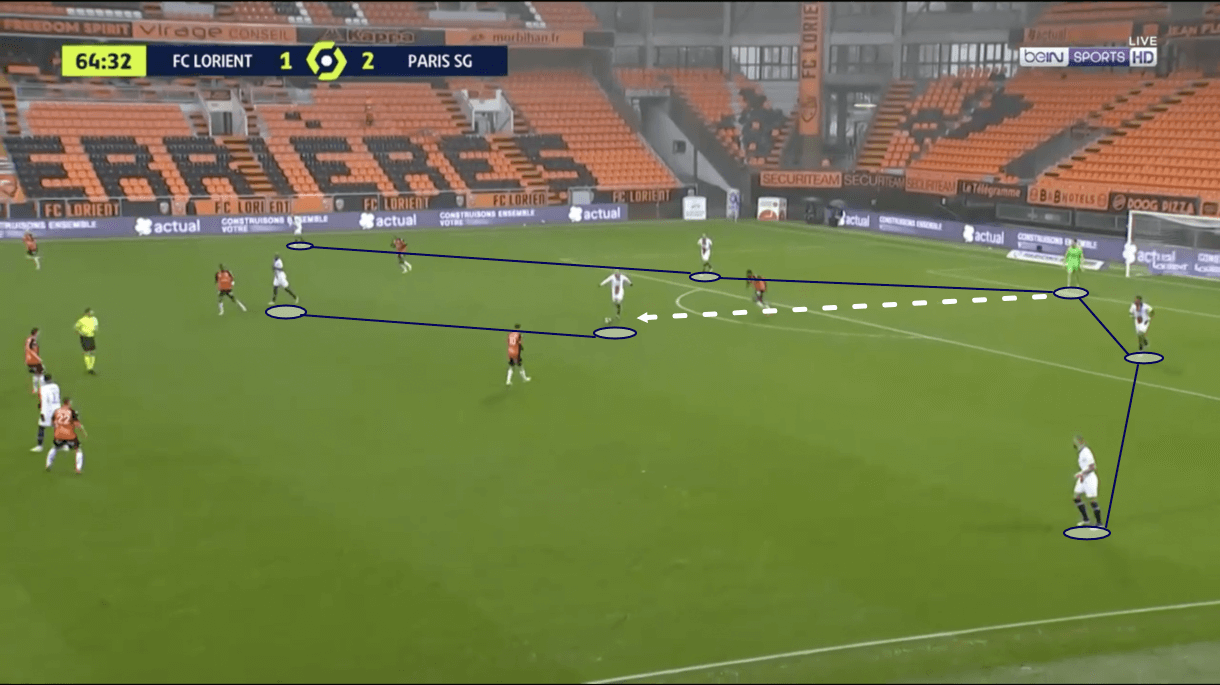
The image above shows us an example of this, with Paredes dropping deep, in between the centre-backs but, conveniently, behind Lorient centre-forward Terem Moffi.
Paredes has frequently been dropping into this position between the centre-backs from goal-kicks and in general during the build-up during the early days of Pochettino’s tenure as manager in Paris, regardless of whether or not the opposition centre-forward presents an obstacle like Moffi does here.
Just before this image was taken, Paredes received the ball directly from goalkeeper Sergio Rico before turning, quickly assessing his passing options and playing the ball out wide to left-back Layvin Kurzawa.
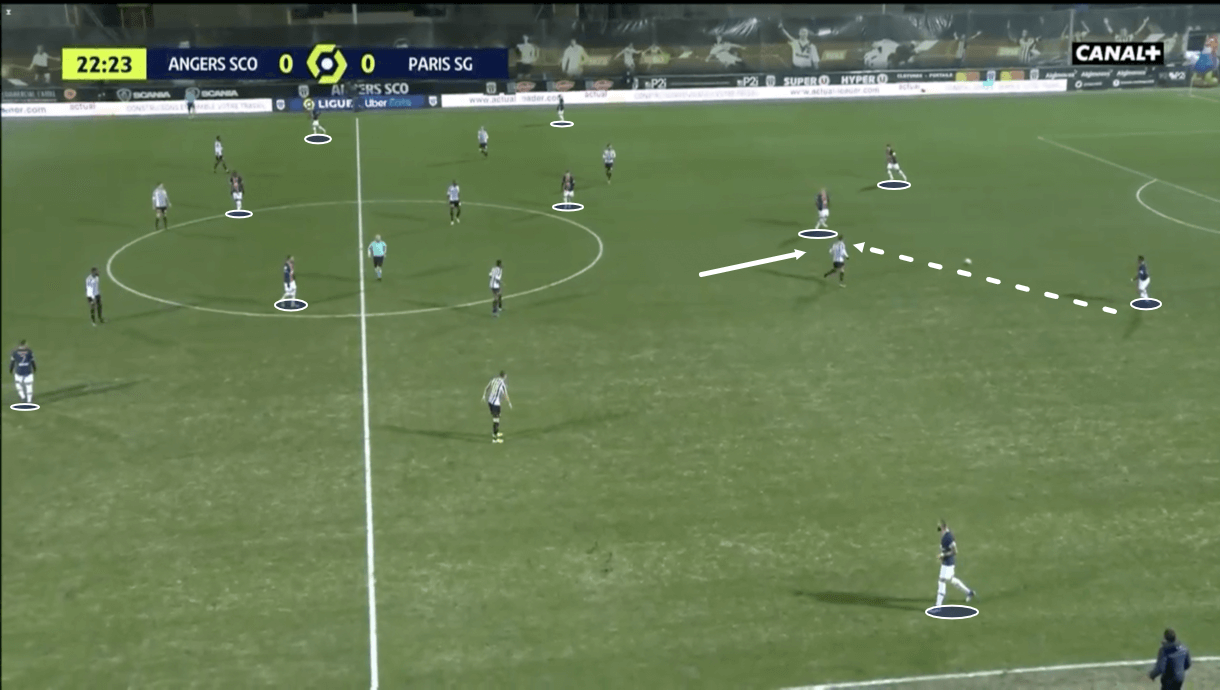
The goal-kicks have skipped the centre-backs and gone straight to Paredes quite often under Pochettino, as seen in the previous image, but even when the ball is played to one of the two centre-backs first, as was the case in this next example above, taken from Les Parisiens’ 16th January 1-0 win over Angers, they will then look to find Paredes a lot of the time, rather than try to take the ball a significant distance forward themselves.
Instead, PSG have been trying to make use of Paredes’ ability to play quality line-splitting passes to progress out of their own third into the middle third of the pitch.
So, these previous two images do a helpful job of illustrating that PSG’s build-up play has typically been going through Paredes in its early stages quite a lot of late, and perhaps this gives us an indication of one potentially key element of Pochettino’s tactics at PSG moving forward, as well as the potentially key role that Paredes may well have in that system.
We can see in this image above from the Angers game that when Paredes receives the ball here, he has a plethora of potential passing options available to him, which Pochettino will undoubtedly have planned.
He’ll want the deep-lying midfielder to have plenty of options available and the time and space he needs to pick out the best one.
Kurzawa is free out on the left-wing, Mbappé can be seen making a run in behind the defensive line from the left-wing, Neymar can be seen in between the lines in the ‘10’ position having just dropped off and found some space in a dangerous area for himself – particularly because Paredes is more than capable of picking him out there, while Paredes’ midfield partner Verratti is at an angle offering a short-passing option, which both offers a genuine passing option and attracts the attention of opposition midfielders due to the threat that he also poses on the ball, creating space for the likes of Neymar higher up the pitch.
A lot of the time, Paredes has made use of Verratti, playing the ball on to him where he can then progress it further.
PSG have played through the centre fairly often under Pochettino like this in a fairly organised manner and as we can see, the threat posed by the players in those central positions attracts lots of attention, creating buckets of space out wide.
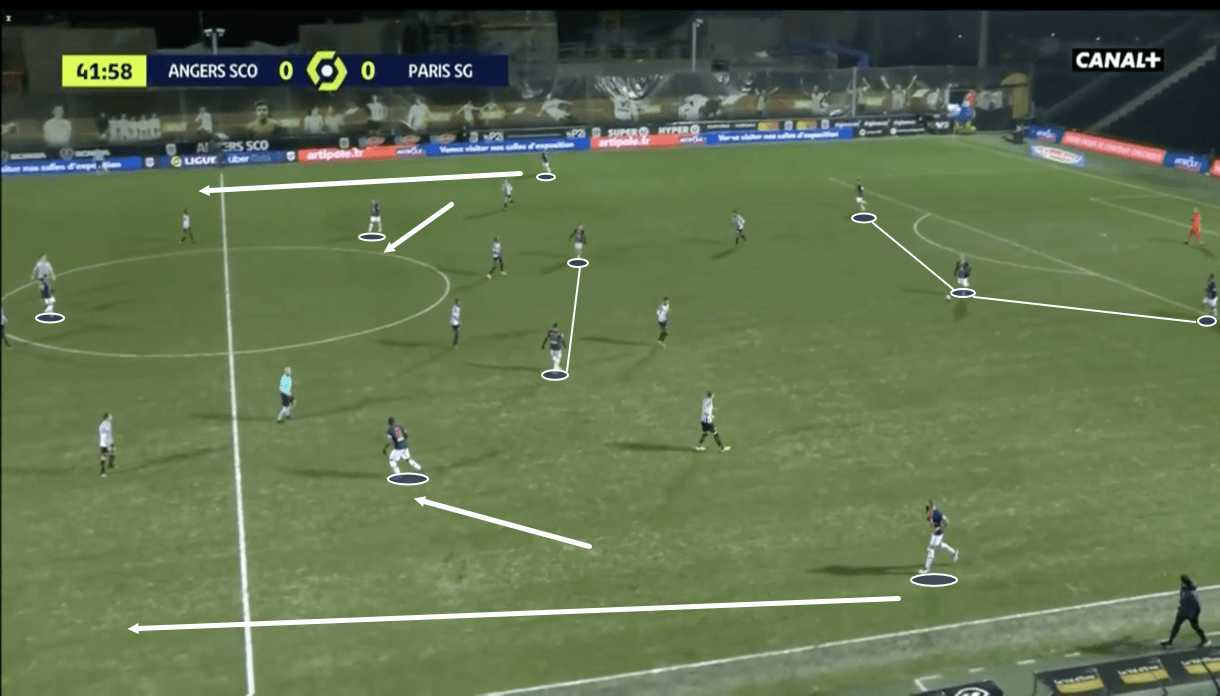
This next image shows us another example of PSG’s build-up versus Angers with Paredes splitting the centre-backs, but this also shows us an example of Pochettino’s side morphing into their offensive shape, with Neymar dropping deep alongside Verratti, the two wingers pushing inside and the two full-backs driving forward to offer width.
When in the ‘10’ role, Neymar has been dropping slightly deeper when Paredes drops in between the centre-backs, firstly, to offer Verratti support in the centre, but also, because another notable element of PSG’s tactics under Pochettino so far has been how the Argentinian manager has used the Brazilian playmaker’s elite dribbling quality to progress the ball from PSG’s half into the opposition half.
Paredes, or one of the full-backs, will, at times, find Neymar in positions like this before he will then drive PSG upfield through his sheer dribbling quality.
He’s difficult to dispossess, so this does make sense.
As PSG move into the final third, Neymar will settle in a much higher position, which, as mentioned, is how Pochettino likes his ‘10’ to operate, but when you have a tool like Neymar’s dribbling quality, it makes sense why he would free the 28-year-old up earlier on in the passage of play to make use of that ability.
As they get deeper into the final third this shape, which appears like a 3-2-5 at this moment, becomes more of a 2-2-6, with the full-backs providing the width and the dynamic four-man attack interchanging positions, finding space and, if in possession, linking up with one another in and around the penalty area, while Paredes will vacate the centre-back position to rejoin Verratti in midfield, supporting the attack.
Mauricio Pochettino Crosses
Pochettino’s PSG side have played slightly more crosses than Les Parisiens have played on average thus far in the 2020/21 campaign.
In their six games under Pochettino, PSG have played an average of 18.67 crosses per 90, while they’ve played an average of 16.38 crosses per 90 over the course of this season.

This is visualised above, and while we must stress that it is still early days for the Ligue 1 side under Pochettino and there’s no guarantee that they will carry on consistently playing slightly more crosses under the Argentinian, it’s clear that there’s been a slight jump in how often they play a lot of crosses so far.
PSG played over 20 crosses in a game just twice in Tuchel’s last 15 games at Le Parc des Princes, while they’ve already played over 20 crosses three times in Pochettino’s first six games.
So, there’s been a clear switch from the end of Tuchel’s tenure and the start of Pochettino’s tenure in how often they play a relatively large volume of crosses.
Despite this rise in crosses, PSG have statistically contested fewer aerial duels under Pochettino so far.
They’ve contested an average of 22.34 aerial duels per 90 in the 2020/21 campaign so far, while they’ve contested just 19.17 aerial duels per 90 over Pochettino’s first six games, and that’s including the outlier that was Pochettino’s first game – a 1-1 draw with Saint-Étienne, which saw them contest 28 aerial duels.

This is visualised above and we can clearly see that there’s been a bit of a drop off in how often they hit that average level of aerial duels for the 2020/21 campaign in their time under Pochettino.
This, perhaps, isn’t a massive surprise, as contesting lots of aerial duels hasn’t been a typical feature of previous Pochettino sides either.
One potential contributing factor to PSG’s rise in crosses and fall in aerial duels could be that they’ve been playing plenty of low crosses of late.
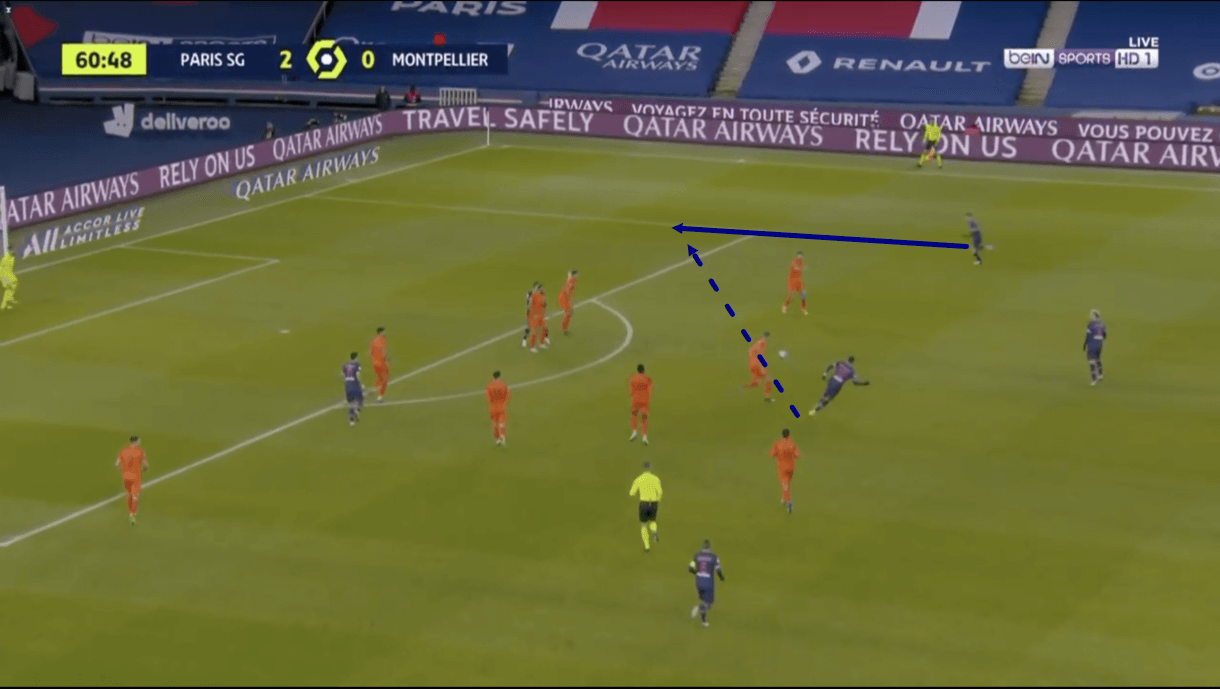
As mentioned, PSG’s full-backs will often provide the width inside the final third, while the front four find space in more central positions.
We can see an example of the opposition defence sitting narrow to try and prevent PSG from playing through them and moving towards goal in the image above, while right-back Alessandro Florenzi provides support for Neymar, on the ball here, via his overlapping run.
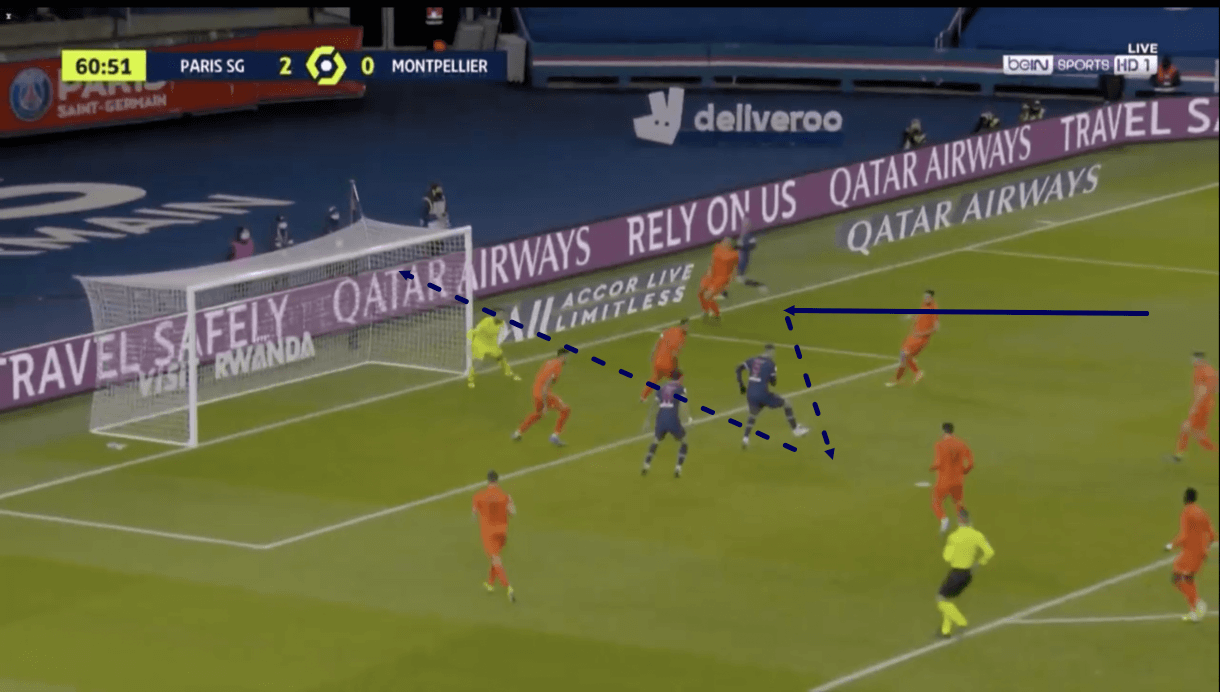
While the full-back is performing an overlapping run, he doesn’t need to be hugging the touchline to do so because of how narrow the opposition backline has been forced and so, he can get onto the end of the ball in quite a central position, carry it towards the byline and ultimately go on to play a hard, low cross into the penalty area.
While Florenzi is carrying the ball towards the byline, Icardi is freeing himself up in the centre via some intelligent, subtle movement.
The Italian right-back can then find the Argentinian striker who can take advantage of a very good goalscoring opportunity at point-blank range to score.
It’s worth noting that Icardi has thrived under Pochettino so far, scoring three goals and providing three assists in his five appearances following his compatriot’s arrival, and it seems that the way in which his movement has been taken advantage of by PSG putting an emphasis on low crosses like this, from either the full-backs or even his fellow attackers if they do end up in those positions, has played a pivotal role in his positive form.
Mauricio Pochettino Pressing
In their two full seasons under Tuchel – the 2018/19 season (8.12) and the 2019/20 season (7.30) – PSG had the lowest PPDA in Ligue 1, indicating that they pressed with the most intensity of any Ligue 1 side.
This is going to continue under Pochettino, whose Spurs side had the lowest PPDA in the Premier League in the 2015/16 season (6.57), while they pressed with more intensity than any team other than Pep Guardiola’s Manchester City in the 2016/17 season (8.13) and the 2017/18 season (8.32).
Tuchel’s PSG and Pochettino’s Tottenham pressed with similar high intensity and it’s very likely Pochettino’s PSG will do so in the long run as well.
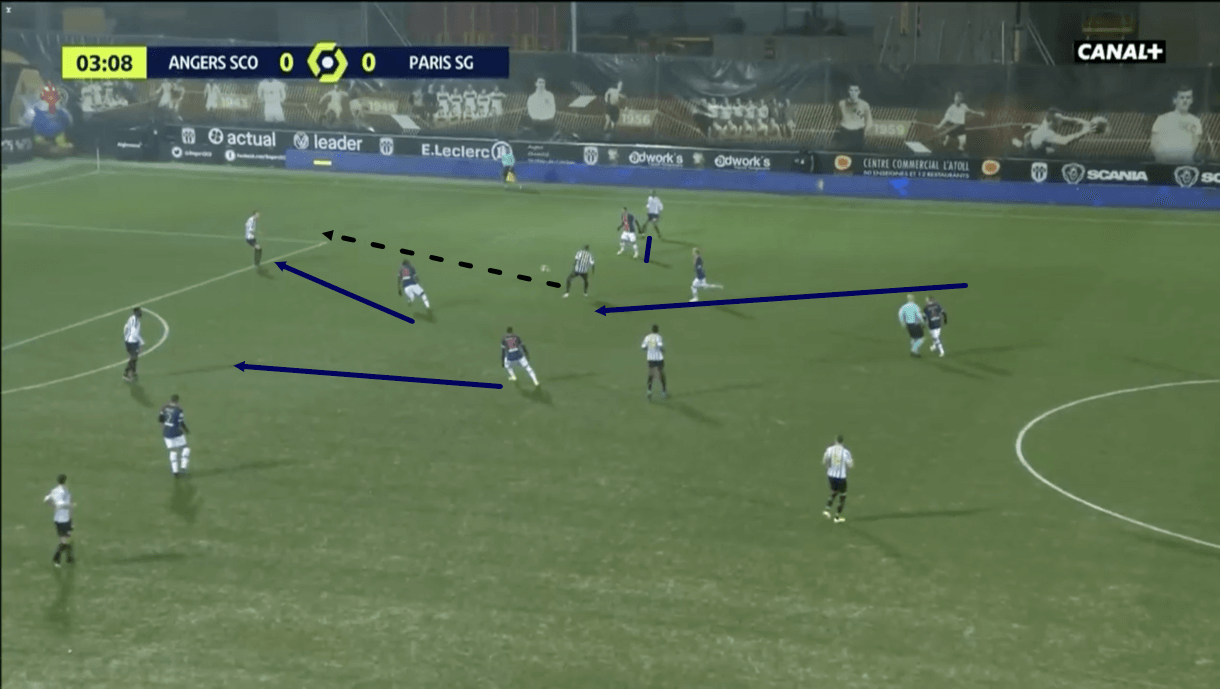
In his short time at the Ligue 1 club so far, this has certainly been the case, and the image above provides us with an example of how PSG have been pressing under Pochettino so far.
Evidently, they have a very high line of engagement, pressing very high up the pitch, the central midfielders push high, sticking tight to the opposition central midfielders even when they drop quite deep to get on the ball like we see here, while the centre-forward, Moise Kean, on this occasion, will press the opposition centre-back and the rest of the front four will also get tight to members of the opposition backline.
This makes it extremely dangerous and difficult for the opposition to play the ball out from the back and often forces them to play a riskier long pass, which can result in a turnover in PSG’s favour.
If they opt not to resort to the long ball, they could be dispossessed by PSG’s attackers/midfielders higher up the pitch, which could lead to a very dangerous counter-attack.
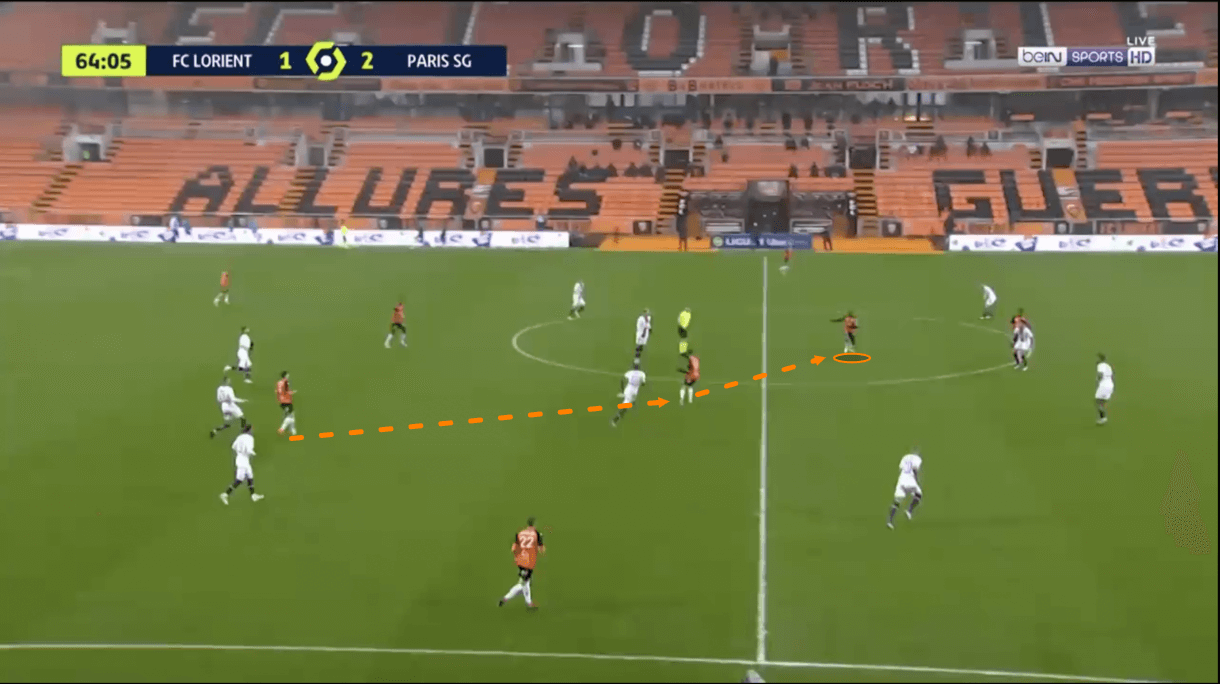
One potential weakness to these aggressive defensive tactics is a weakness that Tuchel similarly had, which is that the way in which PSG’s attackers and midfielders press so high can result in large gaps forming between the midfield and the backline, which an opposition ‘10’ or ‘false 9’ could potentially exploit, as was the case in the image above, versus Lorient – a game that PSG lost 3-2.
They evidently did themselves no favours by allowing these gaps between the lines to form and ultimately be exploited.
Many of the games that Les Parisiens have lost this term have seen the opposition exploit the large gaps that form in this area and so, it seems fair to point out that even though Pochettino has just arrived, it’s a notable issue he may need to iron out.
Conclusion
Again, it is early days in Pochettino’s PSG tenure but it seems reasonable to say that we may have a clear picture of the Argentinian’s vision in some areas, both based on how he has started life at Le Parc des Princes and based on the work he did in previous jobs.
So, in conclusion, this tactical analysis piece highlights some of the key elements to Pochettino’s tactics and philosophy which he has displayed at PSG already and elsewhere, which will hopefully give fans and foes alike of Les Parisiens an idea of what to expect from this team moving forward.

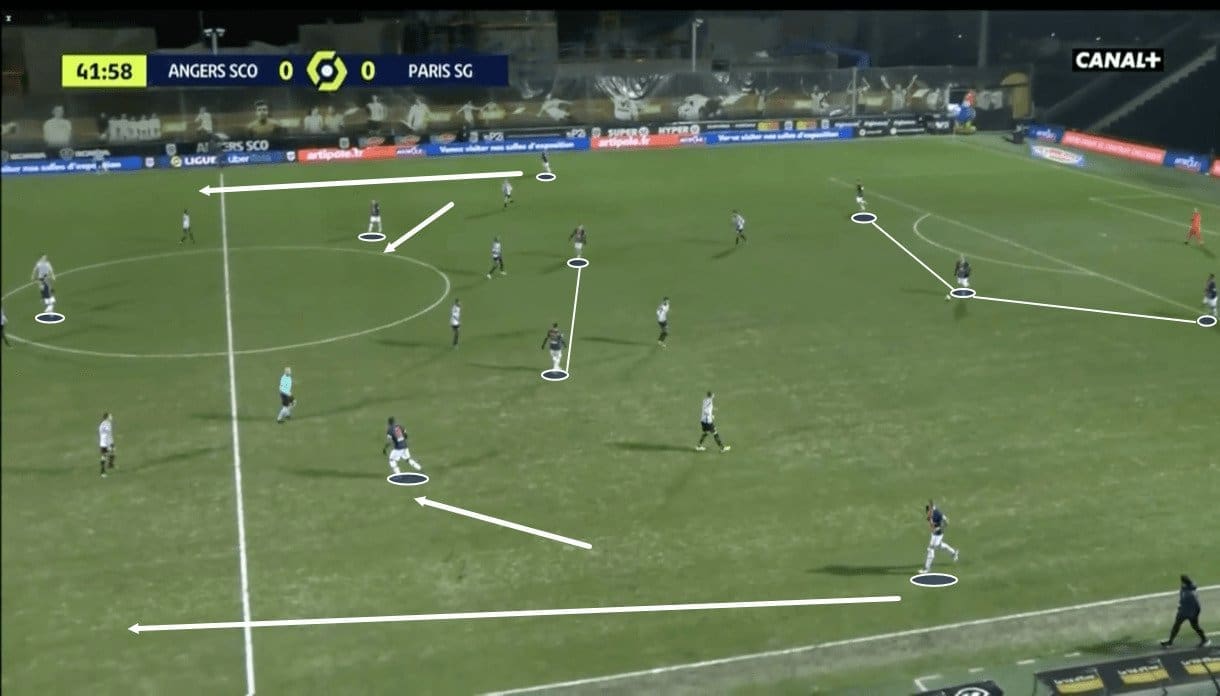



Comments